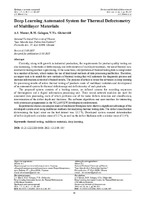Deep Learning Automated System for Thermal Defectometry of Multilayer Materials

Date
2021Publisher
Another Title
Автоматизированная система тепловой дефектометрии многослойных материалов на основе глубокого обучения
Bibliographic entry
Momot, A. S. Deep Learning Automated System for Thermal Defectometry of Multilayer Materials = Автоматизированная система тепловой дефектометрии многослойных материалов на основе глубокого обучения / A. S. Momot, R. M. Galagan, V. Yu. Gluhovskii // Приборы и методы измерений. – 2021. – Т. 12, № 2. – С. 98-107.
Abstract
Currently, along with growth in industrial production, the requirements for product quality testing are also increasing. In the tasks of defectoscopy and defectometry of multilayer materials, the use of thermal nondestructive testing method is promising. At the same time, interpretation of thermal testing data is complicated by a number of factors, which makes the use of traditional methods of data processing ineffective. Therefore, an urgent task is to search for new methods of thermal testing that will automate the diagnostic process and increase information content of obtained results. The purpose of article is to use the advances in deep learning for processing results of active thermal testing of products made of multilayer materials and development of an automated system for thermal defectoscopy and defectometry of such products. The proposed system consists of a heating source, an infrared camera for recording sequences of thermograms and a digital information processing unit. Three neural network modules are used for automated data processing, each of which performs one of the tasks: defects detection and classification, determination of the defect depth and thickness. The software algorithms and user interface for interacting with system are programmed in the NI LabVIEW development environment. Experimental studies on samples made of multilayer fiberglass have shown a significant advantage of the developed system over using traditional methods for analyzing thermal testing data. The defect classification (determining the type) error on the test dataset was 15.7 %. Developed system ensured determination of defect depth with a relative error of 3.2 %, as well as the defect thickness with a relative error of 3.5 %.
Abstract in another language
На сегодняшний день, вместе с ростом темпов промышленного производства повышаются также и требования к контролю качества продукции. В задачах дефектоскопии и дефектометрии многослойных материалов перспективным является использование теплового метода неразрушающего контроля. В то же время, интерпретация данных теплового контроля усложнена рядом факторов, что делает использование традиционных методов анализа данных неэффективным. Поэтому актуальным заданием является поиск новых методов теплового контроля, которые позволят автоматизировать процесс диагностики и повысить информативность полученных результатов. Целью статьи являлось использование достижений в области глубокого обучения для обработки результатов активного теплового контроля изделий из многослойных материалов и разработка автоматизированной системы тепловой дефектоскопии и дефектометрии таких изделий. Предлагаемая система состоит из источника нагрева, тепловизора для регистрации последовательностей термограмм и блока цифровой обработки информации. Для автоматизированной обработки данных используются три нейросетевых модуля, каждый из которых выполняет одну из задач: обнаружение и классификация дефектов, определение глубины залегания дефекта и его раскрытия (толщины). Программные алгоритмы и интерфейс взаимодействия с системой выполнены в среде разработки NI LabVIEW. Экспериментальные исследования на образцах из многослойного стеклотекстолита показали значительное преимущество разработанной системы над методами, использующими традиционные алгоритмы анализа данных теплового контроля. Ошибка определения типа (классификации) дефекта на тестовом образце составила 15,7 %. Разработанная система обеспечила определение глубины дефекта с относительной погрешностью 3,2 %, а также толщины дефекта с относительной погрешностью 3,5 %.
View/
Collections
- Т. 12, № 2[9]
